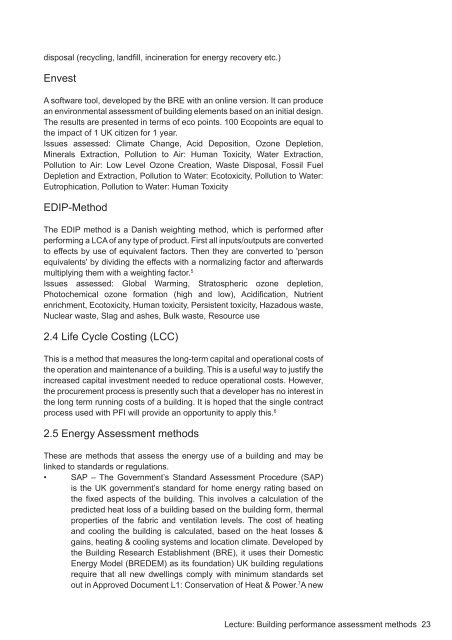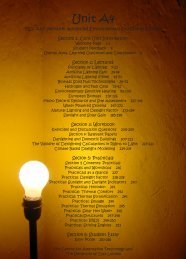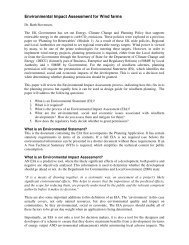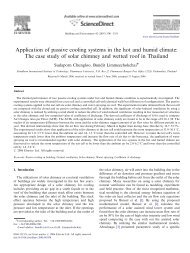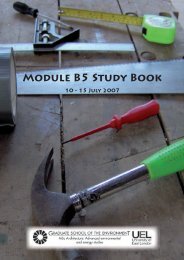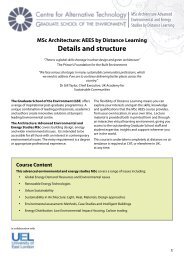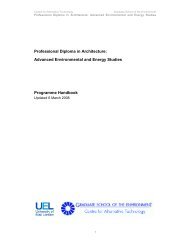Module B1 Study Book - the Graduate School of the Environment
Module B1 Study Book - the Graduate School of the Environment
Module B1 Study Book - the Graduate School of the Environment
Create successful ePaper yourself
Turn your PDF publications into a flip-book with our unique Google optimized e-Paper software.
disposal (recycling, landfill, incineration for energy recovery etc.)<br />
Envest<br />
A s<strong>of</strong>tware tool, developed by <strong>the</strong> BRE with an online version. It can produce<br />
an environmental assessment <strong>of</strong> building elements based on an initial design.<br />
The results are presented in terms <strong>of</strong> eco points. 100 Ecopoints are equal to<br />
<strong>the</strong> impact <strong>of</strong> 1 UK citizen for 1 year.<br />
Issues assessed: Climate Change, Acid Deposition, Ozone Depletion,<br />
Minerals Extraction, Pollution to Air: Human Toxicity, Water Extraction,<br />
Pollution to Air: Low Level Ozone Creation, Waste Disposal, Fossil Fuel<br />
Depletion and Extraction, Pollution to Water: Ecotoxicity, Pollution to Water:<br />
Eutrophication, Pollution to Water: Human Toxicity<br />
EDIP-Method<br />
The EDIP method is a Danish weighting method, which is performed after<br />
performing a LCA <strong>of</strong> any type <strong>of</strong> product. First all inputs/outputs are converted<br />
to effects by use <strong>of</strong> equivalent factors. Then <strong>the</strong>y are converted to 'person<br />
equivalents' by dividing <strong>the</strong> effects with a normalizing factor and afterwards<br />
multiplying <strong>the</strong>m with a weighting factor. 5<br />
Issues assessed: Global Warming, Stratospheric ozone depletion,<br />
Photochemical ozone formation (high and low), Acidification, Nutrient<br />
enrichment, Ecotoxicity, Human toxicity, Persistent toxicity, Hazadous waste,<br />
Nuclear waste, Slag and ashes, Bulk waste, Resource use<br />
2.4 Life Cycle Costing (LCC)<br />
This is a method that measures <strong>the</strong> long-term capital and operational costs <strong>of</strong><br />
<strong>the</strong> operation and maintenance <strong>of</strong> a building. This is a useful way to justify <strong>the</strong><br />
increased capital investment needed to reduce operational costs. However,<br />
<strong>the</strong> procurement process is presently such that a developer has no interest in<br />
<strong>the</strong> long term running costs <strong>of</strong> a building. It is hoped that <strong>the</strong> single contract<br />
process used with PFI will provide an opportunity to apply this. 6<br />
2.5 Energy Assessment methods<br />
These are methods that assess <strong>the</strong> energy use <strong>of</strong> a building and may be<br />
linked to standards or regulations.<br />
• SAP – The Government’s Standard Assessment Procedure (SAP)<br />
is <strong>the</strong> UK government’s standard for home energy rating based on<br />
<strong>the</strong> fixed aspects <strong>of</strong> <strong>the</strong> building. This involves a calculation <strong>of</strong> <strong>the</strong><br />
predicted heat loss <strong>of</strong> a building based on <strong>the</strong> building form, <strong>the</strong>rmal<br />
properties <strong>of</strong> <strong>the</strong> fabric and ventilation levels. The cost <strong>of</strong> heating<br />
and cooling <strong>the</strong> building is calculated, based on <strong>the</strong> heat losses &<br />
gains, heating & cooling systems and location climate. Developed by<br />
<strong>the</strong> Building Research Establishment (BRE), it uses <strong>the</strong>ir Domestic<br />
Energy Model (BREDEM) as its foundation) UK building regulations<br />
require that all new dwellings comply with minimum standards set<br />
out in Approved Document L1: Conservation <strong>of</strong> Heat & Power. 7 A new<br />
Lecture: Building performance assessment methods 23


